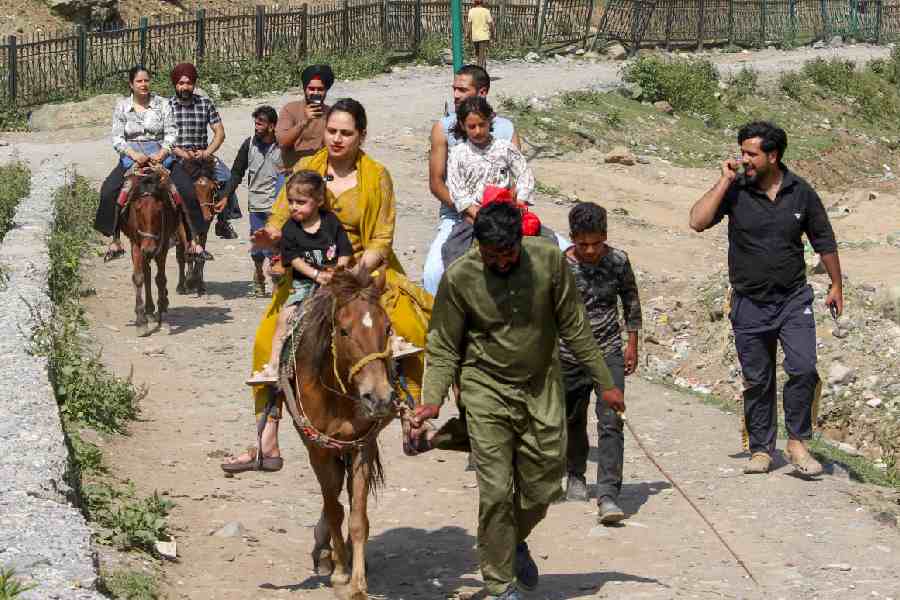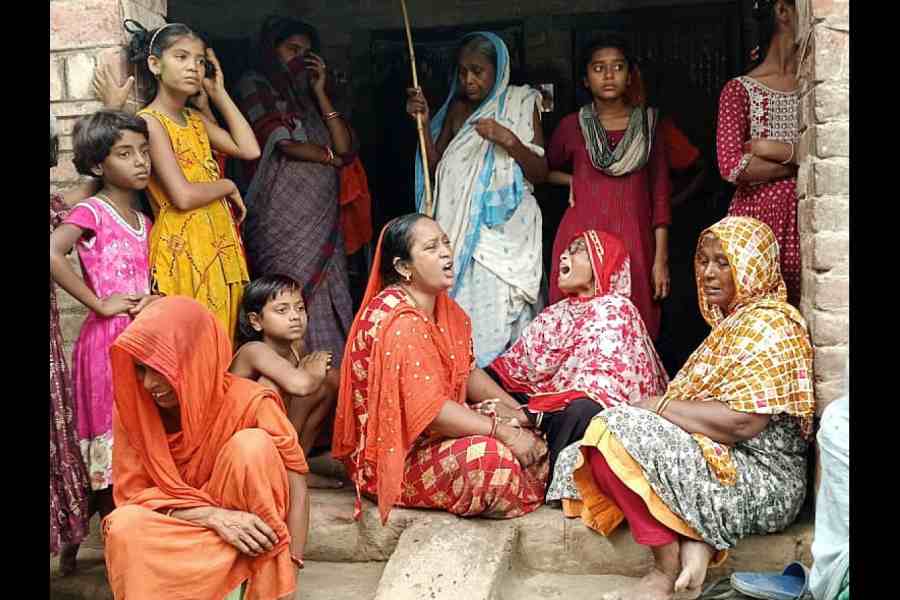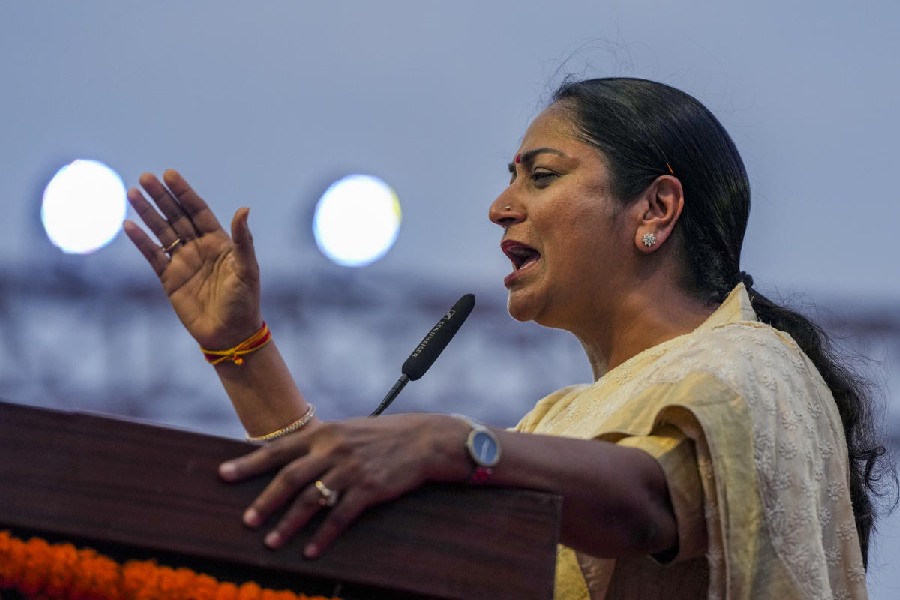 |
 |
| GUN RULE: Maoist rebels in Chhattisgarh; (below) villagers in Dantewada have been armed to fight the Naxals |
Ravideep Singh Sahi never keeps his gun away — not even when he is in his office surrounded by armed guards. “I don’t want to take a chance,” the deputy inspector general of the Central Reserve Police Force says, stroking the AK-47 lying on his desk.
Sahi has reasons to be on guard. Late last month six of his men were killed in a landmine blast triggered by Maoists not far from where his office is located in the district headquarters of Dantewada in Chhattisgarh.
The threat is all too real. On July 12, superintendent of police Vinod Kumar Chaubey and his 35 men were mowed down in Rajnandgaon. Between January and July this year, 107 security men were killed in Chhattisgarh in Maoist attacks.
It is not a question of law and order anymore; the state is on the brink of collapse. Government officials cannot go to villages without being escorted by security forces. Politicians avoid the interiors. “How can a state function effectively despite all the good intentions of the political leadership when you have guns looming over you and you are always looking over your shoulders,” a senior bureaucrat exclaims. Contractors stay away from troubled areas. “The Naxalites either threaten to kill you if you do the construction work or ask for 30 to 50 per cent of the project cost. On the other hand, government rates remain the same everywhere. So why risk your life as there is no extra incentive to work in troubled areas,” a local civil contractor says. Chhattisgarh is in a state of siege.
The state accounts for nearly half of the 3,900 deaths in Naxalite violence reported from 10 affected states since 2004, says a Union home ministry report. In the state itself, over 600 people were killed and almost as many maimed in Maoist attacks over the last two years, says director general of police Vishwa Ranjan.
An estimated 9,000 armed Maoist cadres — backed by some 50,000 militias or sangam members — rule much of the 18 districts that make up tree-covered, mineral-rich Chhattisgarh, a tribal-dominated state carved out of Madhya Pradesh in November 2000.
In the last two years, Maoists, led by its shadowy local military commander Ganpati, have ripped up roads, blown up vehicles, looted banks and markets and torched government properties, causing damage worth Rs 3,728 crore, officials say.
The Maoist writ runs unchallenged in most parts. The administration is shaky, and development work has come to a grinding halt in large swathes of the state, a fact acknowledged by chief minister Raman Singh. “We are trying our best but these Maoists are stopping government work wherever they can through force and intimidation,” Singh says.
A Dantewada lawyer says that few dare go to the police these days. “People are either under pressure from the Maoists to stay away from the police or worry that they will be mistaken for Naxalites and shot if they try to enter a police station, especially after dark,” he says. A senior police officer concedes that the number of complaints in police stations has plunged sharply in interior villages over the last few years.
Not surprisingly, policemen are edgy. “Stop and identify yourself,” a sentry barks from the roof of a police station in Bacheli area in Dantewada, pointing his assault rifle at this correspondent. “It is hard to tell who is a Naxalite these days, so we have to stop everybody at the gate,” explains a policeman.
Security analysts warn that the grim situation in Chhattisgarh is spiralling out of control. “Things are getting worse by the day with more and more security personnel being killed,” New Delhi-based Institute of Conflict Management executive director Ajai Sahni says, calling for “immediate national attention and response” to the worsening situation.
Armed violence in the state had its roots in the jungles of Bastar, where Naxalites, on the run from the police, started holing up in the early seventies. Bastar — now split into five districts, including Dantewada — is the worst affected region of Chhattisgarh.
Dantewada, some 85 km from the nearest railhead of Jagdalpur, reflects the state of neglect. To this day, the district headquarters has no petrol pump. “You can well imagine the condition in the villages where few government officials go,” says a trader.
The state, many admit, is caught in a bind. If underdevelopment has helped left-wing extremism blossom, the resultant violence now comes in the way of development.
But for all the violence, the government insists that it is doing its best to feed the poor — if for nothing else, then at least to rob the Maoists of their main weapon, a hungry stomach. The Raman Singh government, into its second term, is providing rice at Rs 2 a kg to three million families below the poverty line and at Rs 1 a kg to 700,000 poorer families. Each family gets 35 kg of rice a month.“I want to create a hunger-free Chhattisgarh,” Singh says.
Senior IAS officer N. Baijendra Kumar says the government intends to table a model law, tentatively called the Chhattisgarh Food Entitlement Act, in the next session of the assembly, giving people the right to food.The administration, however, admits that many schemes are in a shambles in Naxalite-dominated areas for want of monitoring. “How can you review government schemes properly under the circumstances? I visit remote areas but only after elaborate security arrangements are made,” says Bastar divisional commissioner Manoj Kumar Pingua.
The administration’s reach is shrinking by the day. Dantewada district collector Rina Kangale says they are able to “carry out work only in some pockets” in four of the seven blocks in the district. “Much of the district has become a no-go area for officials,” she notes.
A stone’s throw from the collector’s office is Sitalanka, the first and the oldest camp of the salwa judum — a civilian militia group — in Dantewada. These tribesmen have been pushed into anti-Naxalite operations as special police officers (SPOs), and have virtually become cannon fodder in the government’s battle against the Maoists.
Yet, when it comes to pay, they get much less than their counterparts in the police. “We are paid Rs 2,100 a month as a stipend, while a policeman gets at least Rs 8,000, besides other facilities,” says disgruntled SPO Bodruram Bhaskar, who has just returned from an all-night operation. He says he and his fellow SPOs often trudge through dense forests in pelting rain in search of Maoists.
“The policemen mostly stay behind, asking us to go forward. We don’t know when we will get ambushed,” says Suduram Ichham, another tribal in the camp whose two brothers were killed by Maoists after he joined the salwa judum.
Little wonder that the controversial movement — which started in the mid 2000s — seems to be disintegrating. The number of camp dwellers has almost halved from 60,000 in the 23 salwa judum camps in Dantewada and Bijapur. The Dantewada district collector, however, links the reduced figure of 35,000 to the “natural tribal instincts to return to their villages.”
The government is trying to hone its security forces. It has set up the Counter Terrorism and Jungle Warfare College (CTJWC) in Kanker to train its police force. But CTJWC director Brigadier B.K. Ponwar feels winning “hearts and minds” is as important as superior fire power in this battle. “The first thing I teach my students, serving state police personnel, is how to build drains and walls to help villagers. That’s how you can win their confidence and gain intelligence about the Naxalites,” the retired army officer says.
The police force has its limitations. Chhattisgarh has a 42,000-strong force, but nearly 10,000 posts remain vacant. About 80 per cent of the vacant posts are in the five troubled districts in Bastar.
There is also a dearth of fire power. “We don’t have enough weapons,” DGP Vishwa Ranjan admits. His department has just recruited 7,000 policemen but needs to hire another 3,000.
CRPF sources say the force doesn’t have enough mine-protected vehicles to ferry jawans. “We place our bullet-proof jackets under the seat to reduce, often in vain, the impact of a mine blast.”
Meanwhile, in a desperate attempt to wean the local youths off violence, the government is trying to send them to Calcutta, Delhi, Mumbai, Chennai and Ahmedabad on vocational courses. “We would like them to get a taste of the outside world and stay away from this conflict zone,” says Bastar district collector R. Shangeetha.
To halt the endless cycle of violence in Chhattisgarh, civil liberty activists have been calling for peace talks. “There must be political engagement and all political parties should come together and initiate a peace process even if you may not want to talk to the Naxalites,” says Chhattisgarh People’s Union for Civil Liberties vice-president Binayak Sen.
“There can be no military solution to the problem,” says Sen, a physician detained under the Unlawful Activities (Prevention) Act in May 2007 and released on bail by the Supreme Court this May.
Not everybody agrees. “How can you talk to those who have faith only in guns, not in democracy,” asks security expert Sahni. “In any case, there is no single person or particular leader to talk to,” Ponwar adds.
To be sure, the government must establish its control of the state first. But good governance and infrastructure development have to follow the security measures. “Or else, people will lose hope,” says CRPF’s Sahi.
At Aastha, a residential school for orphans in Dantewada, Class V student Madkam Vijay has penned his thoughts on what he wants to be when he grows up. “They (the Maoists) have killed my parents but I want to be a doctor and save lives,” he scrawls in a small notebook. In Madkam — and others like him — lies the hope for Chhattisgarh.










